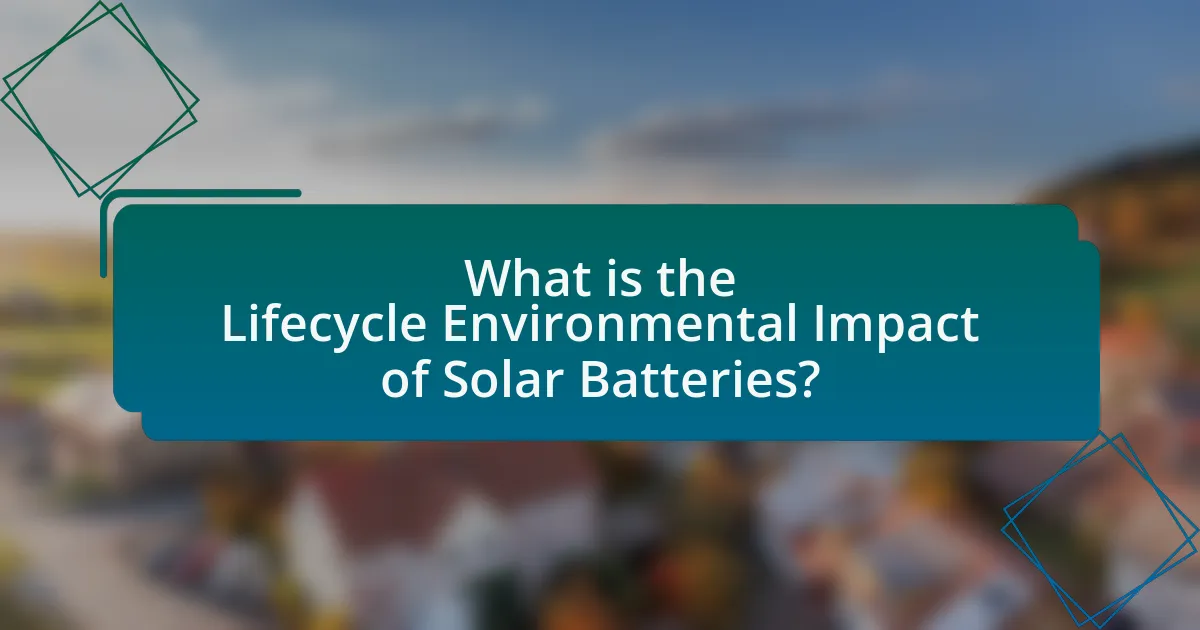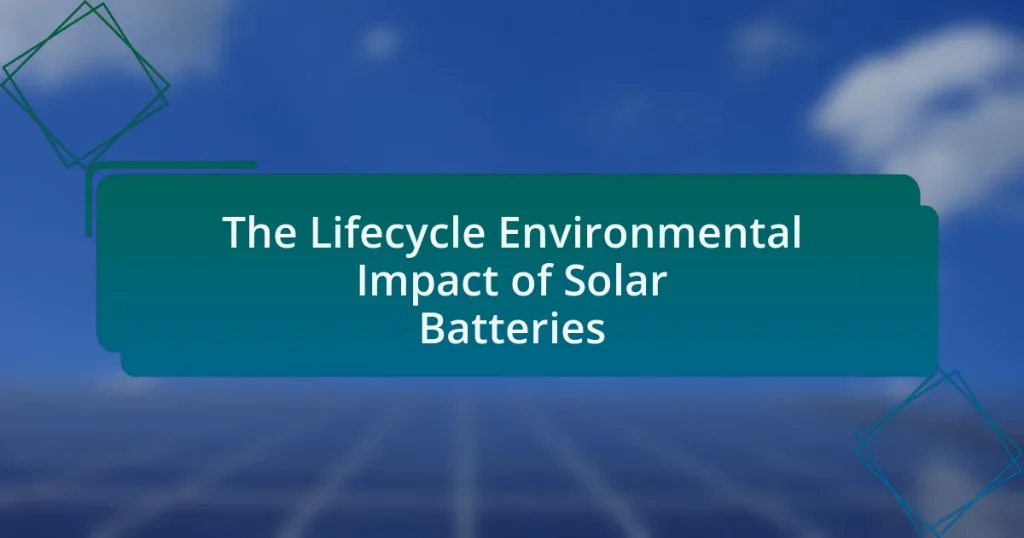The lifecycle environmental impact of solar batteries encompasses several stages, including resource extraction, manufacturing, usage, and end-of-life disposal. Key materials such as lithium, cobalt, and nickel are essential for battery production but pose significant environmental risks during extraction and processing. While solar batteries contribute to reducing greenhouse gas emissions and enhancing energy efficiency by storing renewable energy, improper disposal can lead to toxic pollution. Effective recycling practices are crucial for mitigating these impacts, recovering valuable materials, and promoting sustainability within the solar energy sector. The article examines these aspects in detail, highlighting the environmental benefits, challenges, and best practices associated with solar batteries.
What is the Lifecycle Environmental Impact of Solar Batteries?


The lifecycle environmental impact of solar batteries includes resource extraction, manufacturing, usage, and end-of-life disposal. Resource extraction for materials like lithium, cobalt, and nickel can lead to habitat destruction and pollution. Manufacturing processes consume energy and generate greenhouse gas emissions. During usage, solar batteries contribute to reducing reliance on fossil fuels, thus lowering overall emissions. However, at the end of their lifecycle, improper disposal can result in toxic chemical leaching into soil and water. Studies indicate that recycling can mitigate these impacts by recovering valuable materials and reducing the need for new resource extraction.
How do solar batteries contribute to environmental sustainability?
Solar batteries contribute to environmental sustainability by enabling the storage and efficient use of renewable energy, primarily from solar panels. This capability reduces reliance on fossil fuels, thereby decreasing greenhouse gas emissions. For instance, a study by the National Renewable Energy Laboratory found that integrating solar batteries can lead to a 40% reduction in carbon emissions compared to traditional energy sources. Additionally, solar batteries facilitate energy independence and resilience, allowing communities to utilize clean energy even during grid outages, further promoting sustainable energy practices.
What are the key environmental benefits of using solar batteries?
The key environmental benefits of using solar batteries include reducing greenhouse gas emissions, enhancing energy efficiency, and promoting renewable energy usage. Solar batteries store excess energy generated from solar panels, which can be used during periods of low sunlight, thereby decreasing reliance on fossil fuels. This transition to renewable energy sources significantly lowers carbon emissions; for instance, the U.S. Environmental Protection Agency estimates that solar energy can reduce carbon dioxide emissions by up to 90% compared to coal. Additionally, solar batteries help to stabilize the grid, reducing the need for peaker plants that typically run on fossil fuels, further contributing to environmental sustainability.
How do solar batteries reduce carbon emissions?
Solar batteries reduce carbon emissions by storing energy generated from renewable sources, primarily solar power, which displaces the need for fossil fuel-based energy. When solar energy is harnessed during peak sunlight hours, solar batteries capture and store this energy for later use, thereby minimizing reliance on grid electricity that often comes from carbon-intensive sources. According to the U.S. Department of Energy, integrating solar batteries into energy systems can lead to a reduction in greenhouse gas emissions by enabling a higher percentage of renewable energy usage, thus decreasing the overall carbon footprint associated with electricity consumption.
What are the stages in the lifecycle of solar batteries?
The stages in the lifecycle of solar batteries include manufacturing, usage, and end-of-life disposal or recycling. During the manufacturing stage, raw materials such as lithium, cobalt, and nickel are extracted and processed to create battery components. The usage stage involves the deployment of solar batteries in energy systems, where they store energy generated from solar panels for later use. Finally, the end-of-life stage encompasses the disposal or recycling of batteries, which is crucial for minimizing environmental impact and recovering valuable materials. According to the International Renewable Energy Agency, effective recycling can recover up to 95% of battery materials, highlighting the importance of this final stage in the lifecycle.
What happens during the production phase of solar batteries?
During the production phase of solar batteries, raw materials such as lithium, cobalt, and nickel are extracted and processed to create battery components. These materials undergo refining and chemical treatment to achieve the necessary purity and form for battery manufacturing. The production process involves assembling these components into cells, which are then integrated into battery packs. This phase is energy-intensive, often relying on fossil fuels, which contributes to greenhouse gas emissions. According to a study by the International Energy Agency, the production of lithium-ion batteries can result in significant carbon emissions, highlighting the environmental impact associated with this phase.
How does the usage phase impact the environment?
The usage phase of solar batteries significantly impacts the environment by influencing energy efficiency and emissions. During this phase, solar batteries store and release energy, which can reduce reliance on fossil fuels and lower greenhouse gas emissions. For instance, a study by the National Renewable Energy Laboratory found that integrating solar batteries into energy systems can decrease carbon emissions by up to 80% compared to traditional energy sources. Additionally, the efficiency of solar batteries during their usage phase determines how much energy is wasted; higher efficiency leads to less environmental strain. Therefore, the usage phase is crucial in shaping the overall environmental footprint of solar batteries.
What are the environmental considerations during the disposal phase?
During the disposal phase of solar batteries, key environmental considerations include the management of hazardous materials, recycling processes, and the prevention of soil and water contamination. Proper disposal methods are essential to mitigate the release of toxic substances, such as lead and lithium, which can harm ecosystems. For instance, the U.S. Environmental Protection Agency (EPA) emphasizes the importance of recycling lithium-ion batteries to recover valuable materials and reduce landfill waste. Additionally, regulations like the Battery Directive in the European Union mandate the safe disposal and recycling of batteries to minimize environmental impact. These measures ensure that the disposal phase aligns with sustainability goals and protects environmental health.
What materials are used in solar batteries and their environmental implications?
Solar batteries primarily use lithium, cobalt, nickel, and graphite as their main materials. Lithium-ion batteries, which are the most common type used in solar energy storage, rely on lithium for energy density, cobalt for stability, nickel for capacity, and graphite for conductivity.
The environmental implications of these materials are significant. Lithium extraction can lead to water depletion and pollution in mining regions, particularly in areas like South America’s lithium triangle. Cobalt mining often involves unethical labor practices and can result in habitat destruction. Nickel mining contributes to deforestation and soil degradation, while graphite mining can lead to air and water pollution.
These environmental impacts highlight the need for sustainable sourcing and recycling practices to mitigate the ecological footprint of solar batteries throughout their lifecycle.
What are the primary materials used in solar battery production?
The primary materials used in solar battery production include lithium, cobalt, nickel, and graphite. Lithium is essential for the production of lithium-ion batteries, which are widely used in solar energy storage systems. Cobalt and nickel are often used in the cathodes of these batteries to enhance energy density and stability. Graphite serves as the anode material, facilitating the flow of lithium ions during charging and discharging. These materials are critical for the efficiency and performance of solar batteries, as evidenced by their prevalence in the market and their role in advancing renewable energy technologies.
How do these materials affect the environment during extraction?
The extraction of materials for solar batteries significantly impacts the environment through habitat destruction, pollution, and resource depletion. Mining activities often lead to deforestation and soil erosion, disrupting local ecosystems and biodiversity. For instance, lithium extraction, commonly used in solar batteries, can result in water depletion and contamination in surrounding areas, as seen in the lithium-rich salt flats of South America, where water resources are critically affected. Additionally, the extraction process can release harmful chemicals into the environment, contributing to air and water pollution. These environmental consequences highlight the need for sustainable practices in the sourcing of materials for solar batteries.
What are the recycling options for solar battery materials?
Recycling options for solar battery materials include mechanical recycling, hydrometallurgical processes, and pyrometallurgical methods. Mechanical recycling involves shredding and separating battery components to recover valuable materials like lithium, cobalt, and nickel. Hydrometallurgical processes utilize chemical solutions to extract metals from battery waste, achieving high recovery rates. Pyrometallurgical methods involve high-temperature smelting to recover metals, though they may result in higher emissions. According to a study published in the journal “Renewable and Sustainable Energy Reviews,” these methods can recover up to 95% of valuable materials from spent lithium-ion batteries, demonstrating their effectiveness in recycling solar battery materials.
How do regulations impact the lifecycle environmental impact of solar batteries?
Regulations significantly influence the lifecycle environmental impact of solar batteries by establishing standards for manufacturing, usage, and disposal. These regulations can mandate the use of environmentally friendly materials, thereby reducing harmful emissions during production. For instance, the European Union’s Battery Directive requires manufacturers to minimize hazardous substances and promote recycling, which directly lowers the environmental footprint of solar batteries. Additionally, regulations can incentivize the development of more efficient recycling processes, ensuring that valuable materials are recovered and reused, further mitigating environmental impacts.
What are the current regulations governing solar battery production?
Current regulations governing solar battery production primarily focus on safety, environmental impact, and recycling. In the United States, the Environmental Protection Agency (EPA) enforces regulations under the Resource Conservation and Recovery Act (RCRA), which classifies certain battery types as hazardous waste if they contain toxic materials. Additionally, the Battery Act mandates proper labeling and recycling of batteries to minimize environmental harm. In Europe, the Battery Directive requires manufacturers to adhere to strict recycling targets and ensure that batteries are collected and treated properly at the end of their life cycle. These regulations aim to mitigate the environmental impact of solar batteries throughout their lifecycle, ensuring safe production, usage, and disposal.
How do these regulations influence environmental practices in the industry?
Regulations significantly influence environmental practices in the solar battery industry by mandating compliance with standards that reduce pollution and promote sustainable resource use. For instance, regulations such as the Resource Conservation and Recovery Act (RCRA) in the United States require proper disposal and recycling of hazardous materials, which compels manufacturers to adopt eco-friendly practices. Additionally, the European Union’s Battery Directive sets stringent requirements for battery recycling and waste management, leading to increased investment in recycling technologies and processes. These regulatory frameworks drive innovation and encourage companies to implement cleaner production methods, ultimately minimizing the environmental impact associated with solar battery lifecycle.
What are the challenges associated with the lifecycle environmental impact of solar batteries?
The challenges associated with the lifecycle environmental impact of solar batteries include resource extraction, manufacturing emissions, and end-of-life disposal. Resource extraction for materials like lithium, cobalt, and nickel can lead to significant environmental degradation, including habitat destruction and water pollution. Manufacturing processes for solar batteries often involve high energy consumption and greenhouse gas emissions, contributing to climate change. Additionally, the disposal and recycling of solar batteries pose challenges, as improper handling can result in toxic chemical leakage and increased landfill waste. According to a study by the International Renewable Energy Agency, the recycling rates for lithium-ion batteries remain low, highlighting the need for improved recycling technologies and policies to mitigate these environmental impacts.
What are the environmental risks during the production of solar batteries?
The environmental risks during the production of solar batteries include resource extraction, chemical pollution, and energy consumption. Resource extraction for materials like lithium, cobalt, and nickel can lead to habitat destruction and biodiversity loss. The production process often involves hazardous chemicals, which can contaminate air and water if not managed properly. Additionally, the energy-intensive manufacturing process contributes to greenhouse gas emissions, further impacting climate change. For instance, lithium extraction in places like the Salar de Uyuni in Bolivia has raised concerns about water depletion and ecosystem disruption.
How can the industry address the challenges of battery disposal?
The industry can address the challenges of battery disposal by implementing comprehensive recycling programs and developing sustainable disposal technologies. Recycling programs can recover valuable materials such as lithium, cobalt, and nickel, which are essential for new battery production, thus reducing the environmental impact. For instance, a study by the International Energy Agency in 2021 highlighted that effective recycling could recover up to 95% of lithium from used batteries. Additionally, investing in advanced disposal technologies, such as hydrometallurgical processes, can minimize hazardous waste and improve the overall sustainability of battery lifecycle management.
What best practices can be adopted to minimize the environmental impact of solar batteries?
To minimize the environmental impact of solar batteries, adopting best practices such as recycling, using sustainable materials, and improving battery lifespan is essential. Recycling programs for lithium-ion batteries can recover valuable materials like lithium, cobalt, and nickel, reducing the need for new mining and minimizing waste. Utilizing sustainable materials in battery production, such as bio-based or less toxic alternatives, can further decrease environmental harm. Additionally, enhancing battery lifespan through better design and technology reduces the frequency of replacements, thereby lowering overall resource consumption and waste generation. These practices collectively contribute to a more sustainable lifecycle for solar batteries.
How can consumers choose environmentally friendly solar batteries?
Consumers can choose environmentally friendly solar batteries by evaluating their materials, production processes, and end-of-life recyclability. Specifically, they should look for batteries made from sustainable materials, such as lithium iron phosphate, which has a lower environmental impact compared to traditional lithium-ion batteries. Additionally, consumers should consider manufacturers that prioritize eco-friendly production methods, such as using renewable energy in their manufacturing processes. Finally, selecting batteries that offer robust recycling programs ensures that materials can be repurposed, reducing waste and environmental harm. Research indicates that batteries with higher recyclability rates significantly lower their overall lifecycle environmental impact.
What role does innovation play in reducing the environmental footprint of solar batteries?
Innovation plays a crucial role in reducing the environmental footprint of solar batteries by enhancing efficiency, minimizing resource use, and improving recycling processes. Advances in battery technology, such as the development of solid-state batteries, have led to higher energy densities and longer lifespans, which reduce the frequency of replacements and the associated waste. Additionally, innovations in materials science, such as the use of less toxic and more abundant materials, decrease the ecological impact during production. For instance, research indicates that lithium-sulfur batteries can potentially replace conventional lithium-ion batteries, offering a lower environmental impact due to the abundance of sulfur. Furthermore, improved recycling technologies enable the recovery of valuable materials from spent batteries, thereby reducing the need for new raw materials and lowering overall environmental harm.


